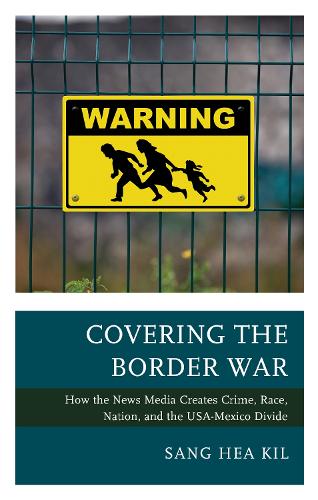
Covering the Border War: How the News Media Creates Crime, Race, Nation, and the USA-Mexico Divide
(Paperback)
Available Formats
Publishing Details
Covering the Border War: How the News Media Creates Crime, Race, Nation, and the USA-Mexico Divide
By (Author) Sang Hea Kil
Bloomsbury Publishing PLC
Lexington Books
15th July 2021
United States
Classifications
Professional and Scholarly
Non Fiction
Media studies: journalism
070.44932772073
Winner of Outstanding Academic Title 2021
Physical Properties
Paperback
232
Width 153mm, Height 231mm, Spine 18mm
367g
Description
Covering the Border War: How the News Media Create Crime, Race, Nation, and the USA-Mexico Divide examines the notion of the body politic in border newspaper coverage of the USA-Mexico divide and how the nation and immigration are racially imagined in crime news discourse, where whiteness is associated with order and brownness is associated with disorder in a variety of imaginative, nativist ways. By applying critical discourse analysis methodology to the Los Angeles Times, Arizona Republic, Albuquerque Journal, and Houston Chronicle during a peak epoch of border militarization policies (19932006), brownness emerges through a news crime frame that reflexively shows the values and meanings of whiteness and the nation. At the body scale, border crossings threaten the whiteness of the national body through suggestions of rape and disfigurement. Border news discourse feminizes the nation with nurturing resources and services under threat of immigrant rape as well as expresses racial anxiety about a changing face of the nation. Border news coverage constructs immigrants as home intruders at the house scale, both human and animal. Whiteness at this scale reflexively signifies a law-abiding, rightful owner of property protecting against criminal trespassing. Brown immigrants are also seen as wild animals, which constructs whiteness burdened with the task of animal management. Whiteness at the regional scale suggests a masculinized, militarized battleground or a settled region threatened by a brown, cataclysmic flood. Finally, the nation scale complements the body scale but in a more contemporary and scientific way. Whiteness reflects a body politic fighting the disease of cancer/immigration in two ways: with an imagined militaristic, immune system and with hi-tech, aggressive operations. This diseased body politic communicates whiteness and nativism about the border through discursive border symptoms and border operations that represent the intersection of immunology discourse, the racial construction of the body politic, and anxiety about postmodern economic transformation and its impact on national borders.
Reviews
Kil (San Jose State Univ.) provides a rigorous analysis of news discourse focusing on how the nation and aspiring immigrants are depicted based on articles published in the Los Angeles Times, Arizona Republic, Albuquerque Journal, and Houston Chronicle from 1993 to 2006. The analysis demonstrates how immigrants have been "racially imagined" as thieves and rapists who drain social services resources and create injury to the suffering (and white) taxpayer. Theoretically rich and methodologically rigorous, this seven-chapter book examines the most recent "nativist wave," which has focused attention on immigrants and the US/Mexico border region. . . Brutalization theory helps Kil explain, throughout, why both the news-reading public and US policy makers might seek to further militarize the border despite the deadly costs of doing so. A comprehensive bibliography completes this engaging and accessible text. Summing Up: Highly recommended. Upper-division undergraduates. Graduate students, faculty, and professionals. * Choice Reviews *
In Covering the Border War: How the News Media Creates Crime, Race, Nation, and the USA-Mexico Divide, Sang Hea Kil examines how the media repeats images of pollution, floods, invasions, and border walls that support white notions of being under attack by brown bodies. Recommended reading for those interested in how whiteness still matters and how the brown threat is used to justify draconian immigration policies. -- Leo Chavez, University of California, Irvine
Author Bio
Sang Hea Kil is associate professor in the justice studies department at San Jose State University.
